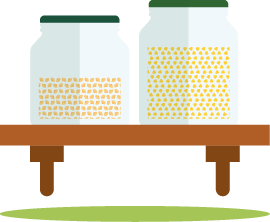
Quinoa is a small, round pseudo-grain that comes in various colours, including white, red, and black. A pseudo-grain refers to a seed that is consumed in the same way as a cereal grain but doesn’t come from the “true” cereal botanical family (named Poaceae), which includes common grains such as wheat, barley, rice, and rye. Other common pseudograins are amaranth and buckwheat.
Quinoa has a mild, nutty taste and a slightly chewy texture when cooked. Originating from the Andean region of South America, quinoa has been a dietary staple in countries like Peru and Bolivia for over 5000 years.
Quinoa works well for both warm and cold grain salads. It’s also popular in sides and pilafs and pairs well with ingredients such as corn, black beans, avocado, citrus, cilantro, peppers, and tomatoes.

Nutritionally, quinoa is high in fibre, magnesium, phosphorus, iron, zinc, copper, thiamine (vitamin B1), vitamin B6, and folate. Quinoa is also a source of potassium, and riboflavin (vitamin B2).
Quinoa is gluten-free, making it suitable for those with gluten intolerance or coeliac disease.

Toggle with the tables below to compare their nutritional content per 100 g (both cooked and uncooked) and per average portion size. You might be surprised by the differences!
| Grains | Kcal | Protein | Fat | Saturated fat | Carbohydrates | Fibre |
|---|---|---|---|---|---|---|
| Quinoa, Per 100 g, cooked | 114.00 | 4 | 1 | 0 | 18 | 2 |
| Quinoa, Per 100 g, uncooked | 354.00 | 14 | 6 | 0 | 57 | 7 |
Whole grains are all packed with carbohydrates and dietary fibre (which is a type of carbohydrate) and are naturally low in (saturated) fat. Fibre is important for our health and the prevention of many chronic diseases. That’s why the European Food Safety Authority (EFSA) recommends we eat at least 25 g of fibre per day. Sometimes, you might see whole grains labelled as ‘high in fibre’ or ‘source of fibre’ – but what does that really mean?
| Grains (% of DRV) | Calcium | Magnesium | Phosphorus | Potassium | Iron | Zinc | Copper | Vit. B1 | Vit. B2 | Vit. B3 | Vit. B6 | Folate |
|---|---|---|---|---|---|---|---|---|---|---|---|---|
| Quinoa, per 100 g, cooked | 2.13 | 19.73 | 21.71 | 8.60 | 10.71 | 10.90 | 19.00 | 10.00 | 7.86 | 2.50 | 8.79 | 12.73 |
| Quinoa, per 100 g, uncooked | 5.88 | 52.53 | 65.29 | 28.15 | 32.86 | 31.00 | 59.00 | 32.73 | 22.86 | 9.38 | 34.79 | 55.76 |
| Quinoa, per portion, cooked | 1.49 | 13.81 | 15.20 | 6.02 | 7.50 | 7.63 | 13.30 | 7.00 | 5.50 | 1.75 | 6.15 | 8.91 |
| Quinoa, per portion, uncooked | 4.11 | 36.77 | 45.70 | 19.71 | 23.00 | 21.70 | 41.30 | 22.91 | 16.00 | 6.56 | 24.35 | 39.03 |
% of DRV stands for dietary reference value. DRV stands for dietary reference value. These values estimate how much of a nutrient most healthy people in Europe need each day. Ideally, we should aim to reach 100% of these values daily. Each vitamin and mineral has their own DRV, as set by EFSA.
You might have heard that whole grains are ‘high in,’ ‘rich in,’ or ‘source of’ a certain vitamin or mineral. These term are regulated by EFSA and products must meet specific rules to be considered as such. Here’s how to interpret these contributions:

Store in an airtight container in a cool, dry place. Follow the instructions on the packaging to keep the food good for as long as possible.
Quinoa have a best-before date, meaning that it can often be eaten after that date has passed. If they look, smell and taste good, and the packaging is also intact, it will most likely be safe.

Follow the instructions on the packaging to cook quinoa. Cooking times can vary depending on the variety and type of quinoa.
As a general rule of thumb, to cook quinoa, use a ratio of 1 part of quinoa to 2 parts of water or broth. Rinse the quinoa under cold water to remove some of its natural bitterness or toast the quinoa on the pot before adding the liquid. Bring to a boil, reduce heat, cover, and simmer for 15-20 minutes until the liquid is absorbed and the grains are tender. Stir occasionally to prevent sticking.

There is no such thing as "non-whole grain" quinoa. Quinoa flour made from whole seeds is considered a whole grain product.
Learn to identify whole grain products, cook delicious meals, find practical tips for a smooth, gradual switch, and much more!